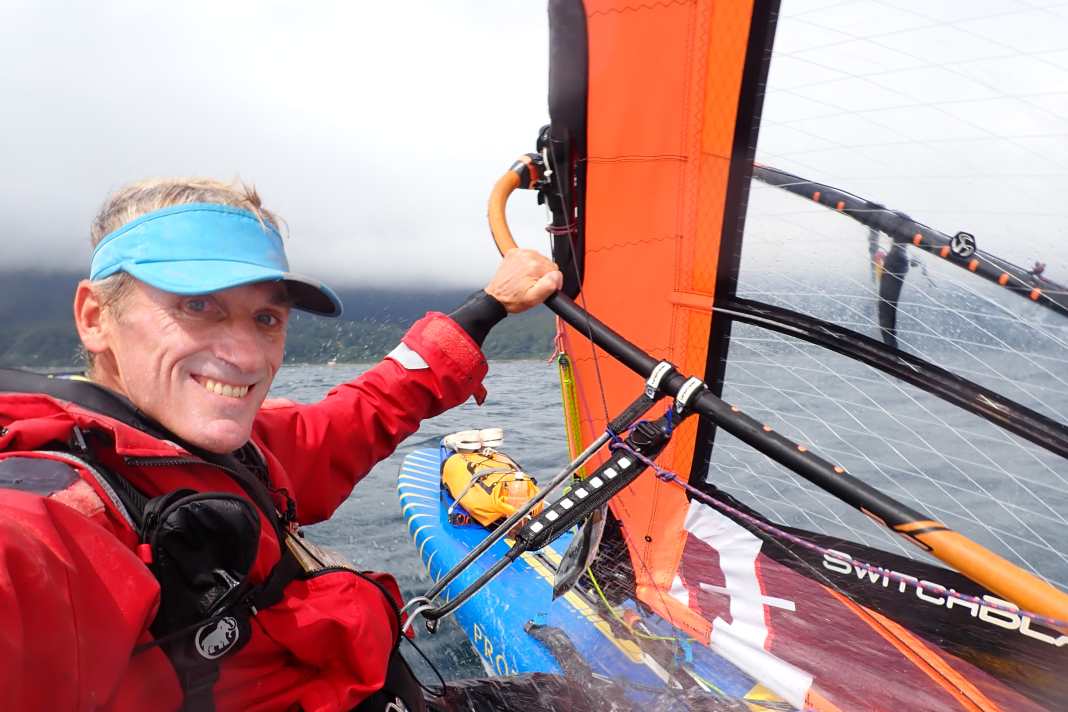





The experiences continue to come thick and fast. A week feels more like a month, a month like a year. In my last update for the surf magazine I was near Sendai. From there, I circumnavigated the city and crossed Sendai Bay (1) on a 45-kilometre-long beat. For the first time in a long time, I landed on sand rather than concrete, and the natural surroundings of Aji Island were a balm for the senses.
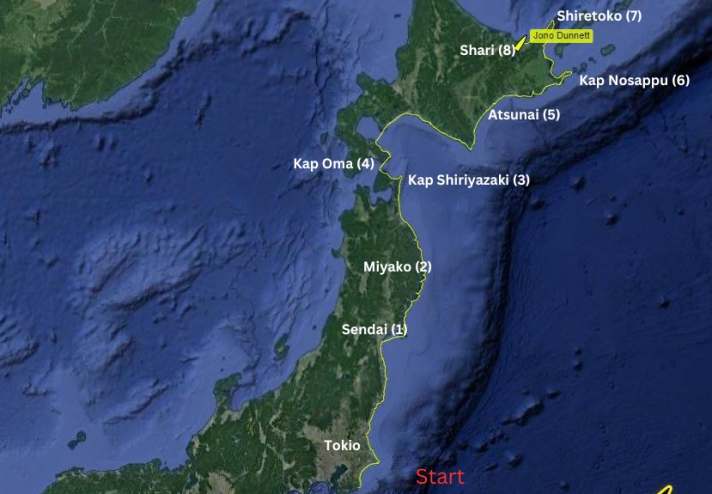
From here onwards, the landscape is magnificent and becomes increasingly steep, reminiscent of Norway. The Sanriku coast comprises a series of deep bays that are wild and spectacular like fjords. But the exposed coastline is made inhospitable by the Pacific swell. The headlands that jut out into the ocean are desolate places and the distances between safe landing sites are unfortunately considerable. Visibility is often impaired by fog, and in most places the wind struggles to make it out of the mountains to the sea. I made do with one or two headlands a day, it was a nerve-wracking affair, because when the wind failed again, it was usually too rocky to paddle.
More about Jono Dunnett's journey:
Whilst circling the headlands, I saw moonfish and, for the first time, albatrosses; accompanying them for a while was a real privilege. As charming as the surroundings were, every mile here was hard-won. The fog descended and I struggled to find a hint of wind to get against the current and pass the headland. The waves bounced off the cliffs, creating annoying cross seas.
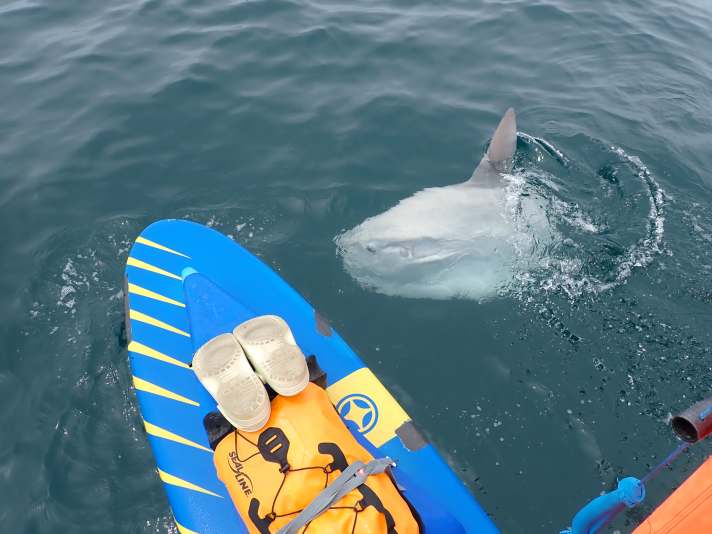
However, the foaming crests of the waves also told me that there must be wind not far from here. At some point there was a hint, then suddenly there was a real pull in the sail. My raceboard shot down the steep wave faces and my expectations for the day changed completely: "Thirty miles today, Jono! Thirty miles!" But within a few minutes, the conditions became too wild. The wind picked up to 30 knots, which was twice as much as I could manage in this swell. I wasn't surfing to the next inlet, I was being surfed. Once there, there was suddenly no wind again. It would have been foolish to continue, so I landed. The landscape here, with towering trees reaching for the light and large-leaved undergrowth plants, reminded me of Jurassic Park. A mountain stream gurgled into the sea, this was wild nature and not a curated version. It was a reminder of how impoverished nature has become in the UK and most of Europe. For dinner, I had one of the freeze-dried meals I keep in reserve for remote places like this. And I slept with bear spray in my hand, just in case.
Windsurf Round Japan - a king in the Konbini
The "Norway section" was exciting, but too difficult to want to stay here. The combination of steep coastline and rough seas was simply complicated, and the language barrier made it difficult to socialise with the locals. With a lot of effort, I made it to Miyako (2), where I ended up at a well-known tourist trap called Jodogahama Beach, where I also met some windsurfers. The logistics of this trip are different from Europe. As there were hardly any pubs or cafés near where I landed, I had to rely heavily on the konbini shops (food shops). These are usually open around the clock and sell everything you need to survive. Looking ahead, I consider the weather, landing options and proximity to a konbini. My favourite konbinis are the "Lawson" ones because they have free wifi and maybe a breakfast bar to sit at.
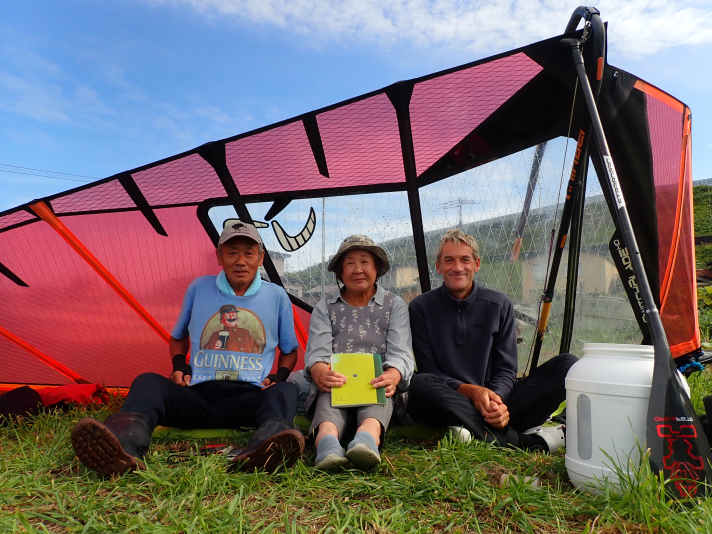
However, charging devices such as smartphones or GPS trackers can be a problem. The konbinis do have power sockets, but there's always the question of whether you'll get permission to plug them in, and I've learnt that it's not customary to charge first and then ask. This is true even when you're drinking the coffee you bought and devouring six-packs of fresh chocolate eclairs. The konbinis also have excellent modern Japanese-style toilets. If you haven't experienced the integrated shower function, you don't know what you're missing. In comparison, European-style toilets are something out of the dark ages.
My destination was now Cape Shiriyazaki (3), the north-easternmost point of Honshu. Once around this cape, it would offer protection from the Pacific swell. The further north I went, the less the coast was protected by concrete or rocks, and there were more small harbours and residential areas near the coast. Obviously the tsunami risk is lower in this region. Some days it felt safe to tour surf up here, other days I got a good thrashing in strong offshore winds and was reminded that I'd better sit out days like that on land again in future. What can I say - as I rounded the cape, a few tears rolled down my face.
I sleep with bear spray in my hand - just in case...
It's the nature of long distance windsurfing that you can only celebrate victories for a short time, as I now had a crossing from Honshu (the "mainland") to Hokkaido (the "north island") on my chest. Looking back, my original plans for the crossing were hair-raising, and I thank my friend Captain Pablo for talking some sense into me and sending me to Cape Granny (4) before I took the plunge. I arrived at Cape Oma on a foggy day and then took advantage of the wind at the edge of a wind field to make my way to the upstream side of the peninsula. That's where it happened.
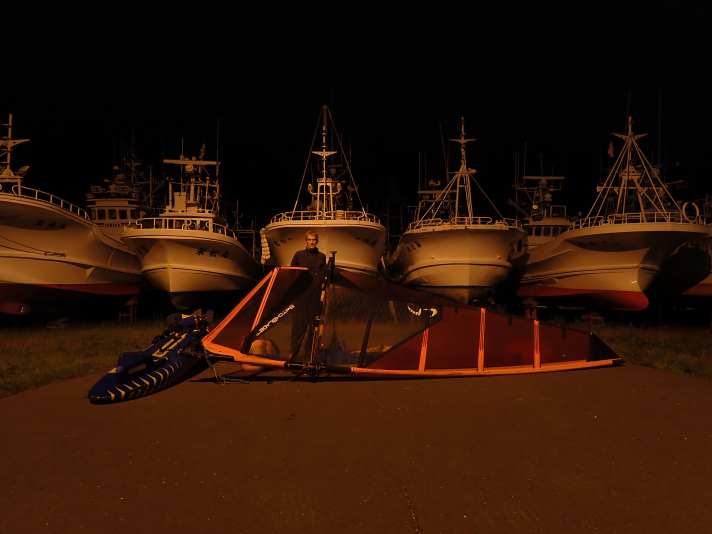
Butterflies in the stomach
I spent three nights in Oma and waited for a suitable day for the crossing. I took the opportunity to visit an onsen, a public hot spring bath, and shave for the first time in a long time - a decision that in retrospect may have been decisive. So, apparently looking reasonably respectable, I went to the konbini to charge my phone and eat chocolate eclairs. And there I saw her, reading a book through the glass of a launderette.
That day it was just a fleeting glance, but the very next day she met me again and we went for a walk and to the onsen. And after the onsen we sat there in silence, too close to be friends. Yumiko, her name, invited me to dinner, and then she put me down by my sail, which had been set up as a roof, in the long grass behind the fishing boats. Maybe just to see if my adventure story was true. The next day we met up again for coffee and as I surfed towards Hokkaido, my head was spinning like in the whirlpools of the Tsugaru Strait.
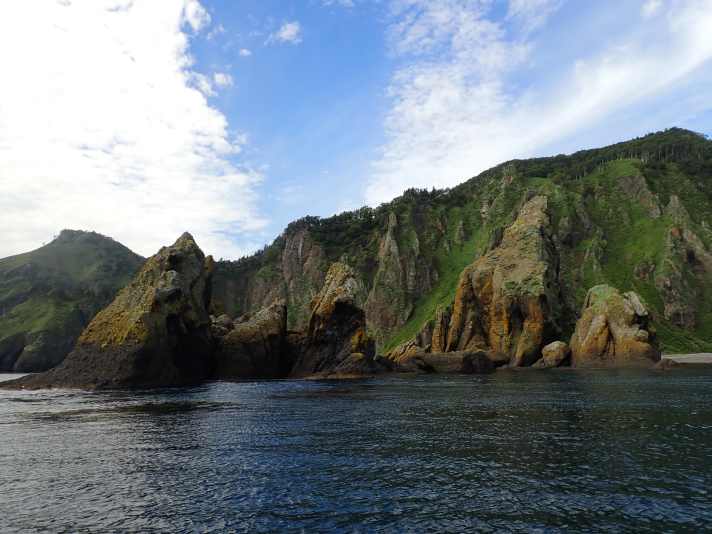
Hokkaido vibes
Hokkaido welcomed me with good vibes, the people are open and friendly, and the scenery is spectacular. On the first day, a fisherman took me in his minibus to a hot spring among the rocks and a family who lived within sight of the harbour insisted that I spend the night with them and fill my stomach with good food. A shortcut through Uchiura Bay provided a first day where dolphins were in abundance, along with plenty of tuna and a hammerhead shark. This was encouraging as I had seen very few dolphins before. At the end of the day, I was met by the coastguard and an unconventional landing routine followed.
It is in the nature of touring surfing that you can only celebrate victories for a short time
Yumiko and I had stayed in touch. She was thinking about a visit. But then she changed her mind. "It's easier, better this way," I told myself, even though I knew something good had slipped away. A few days later she did come to visit me and saved me from two more days of shockingly bad weather in Hiroo.
Next on the programme was the Nemuro peninsula, but on the way there was a problem called Atsunai (5). This small village on the south-east coast of Hokkaido seems to be shrouded in fog. It took me two months to reach Atsunai and then two weeks to get out of there. Waves, headwinds, unpleasant currents, kilometres of fishing nets blocking the way, relentlessly poor visibility - Atsunai was apparently never going to let me go again. Fortunately, the town has a railway station and the locals were very friendly. Looking back, I developed a soft spot for the place after being there for so long. But then it came, the day of departure.
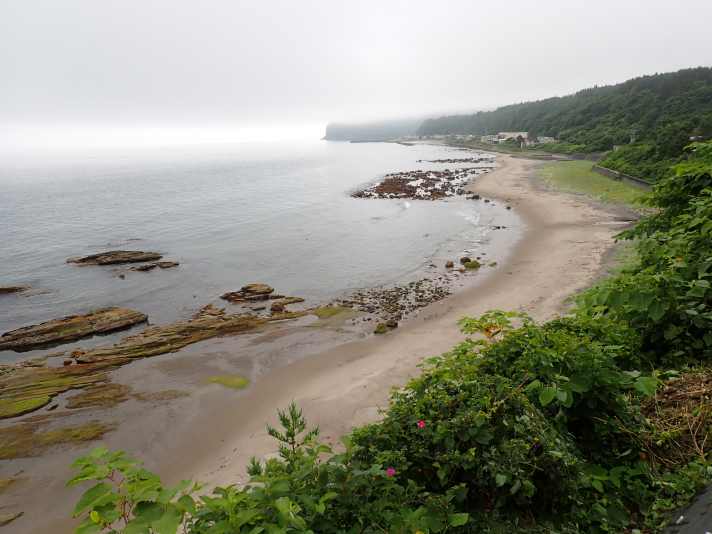
A rough day with uncertain winds brought me around Cape Ochiishi and the next day I rounded Cape Nosappu (6), with a marvellous view of the offshore Kuril archipelago. This day was of great significance, because by rounding the cape I left the Pacific Ocean and entered the much less exposed Sea of Okhotsk.
Windsurf Round Japan - the sea of attrition
Theoretically, it should be easier from here, but the Sea of Okhotsk will go down in my memory as the "sea of attrition". Firstly, the shaft of my paddle broke in Nemuro. I repaired it, but then it broke again elsewhere. A good paddle is essential, so a new one was needed. Thanks to Starboard for the fast delivery! I later damaged my board and sail when I failed to get over floating fishing nets. In this area the nets are very tightly packed and in many cases attached to the shore. I circumnavigated the remote wilderness of the Shiretoko Peninsula (7). The headland is known throughout Japan for its beauty and wildlife, which includes bears.
My schedule is in a mess. I won't make it before the onset of winter
I saw two bears from the sea, wandering along the coast and frolicking on the beach, just like any of us would. I would have happily avoided encounters on land, but one day I wanted to go in search of water shortly after landing. I looked over an old wall to decide which way to go - and saw a big brown bear about 15 metres away, coming closer. I dived under, fished the bear spray out of my pocket, revealed myself again and forcefully told the bear to go away, which it did. This animal was a heavyweight, much bigger than me, but it was easily spooked, like a cow or my family's labradoodle.

I left a fire burning overnight to deter any unwanted visitors and was grateful when dawn broke. It wasn't the easiest place to launch, so I loaded the gear while the board was already in the water. I turned to retrieve my supply barrel from the rocks when suddenly another bear stood in front of me. It was a thinner fellow who had already jumped over the wall and was now only a few metres away. When we recognised each other, we both froze for a moment. My bear spray was already packed away. But my warning voice was now practised: "Shoo! Go away! Get lost!"
Looking back, the bears I met were all easy to scare. They were foraging rather than hunting and looked like men in bear suits. My own fear of these animals subsided and was replaced by something more appropriate: respect. After meeting these animals, the truth is obvious. We are a much bigger threat to them than they are to us. Shiretoko is a national park, but the salmon nets that surround it are just as numerous here as anywhere else. The bears will starve to death if all the salmon are fished out of the sea. It disappoints me that the protection of the national park ends at the coast.
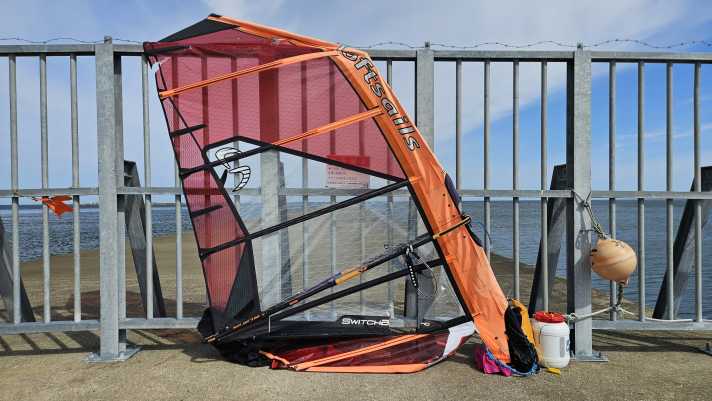
Waiting in company
What makes an adventure are the imponderables. At the beginning of Windsurf Round Japan I might have had a timetable, but that has long since fallen apart. It's a complicated coast, made doubly difficult by the many fishing nets. I'm also travelling around Hokkaido in the "wrong" direction, against the prevailing currents. As a result, my average daily mileage has dropped significantly compared to the European trip. And ever since a sudden gust of wind threw my equipment into a fence in Shari (8), the schedule has been cancelled. The mast is broken, the sail shredded. My sponsors Unifiber and Loftsails are doing what they can to get me a replacement, but at the moment I'm stuck up here. It now seems inevitable that the harsh conditions of winter will hit me before I can escape them.
But there's no reason to be frustrated. Yumiko has come to visit, we've bought a proper tent and as I write these lines for you surf readers, she's cooking us a hot dinner.
See you soon from the Sea of Japan!
Your Jono
Follow Jono Dunnett's journey around Japan in the tracker
At this point, you will find external content that complements the article. You can display and hide it with a click.

